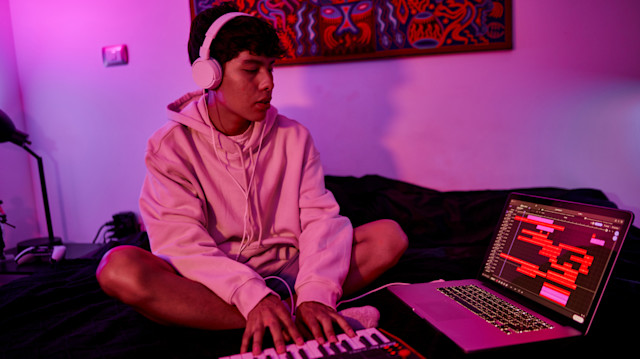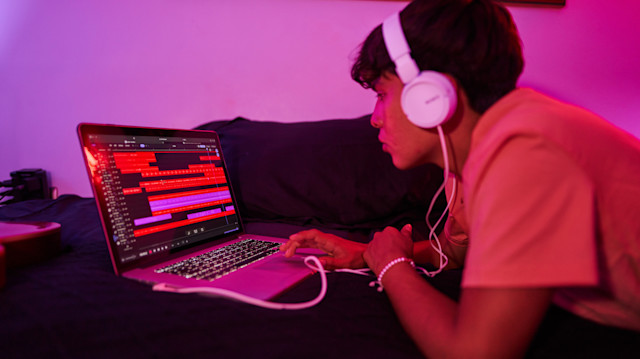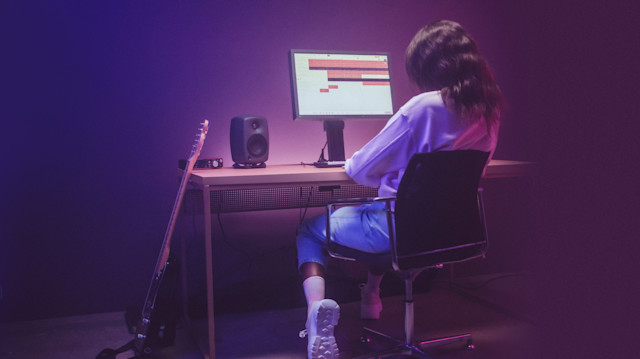Beginner's Guide to Lo-fi Music: Tips for Creating Lo-fi Beats Step-by-Step
September 20, 2023 / Anton Berner

Lo-fi music has seen an uprise in popularity in recent years. Not only is it a trendy beat genre for emcees to rap over, but music listeners tune into Lo-fi playlists to wind down, while studying, or to help them go to sleep. Lo-fi beats are characterized by slow tempos, vintage instruments, soothing melodies, and cloudy soundscapes that make you relax and vibe out to the chill rhythms.
If you’ve decided to learn how to make slow-sizzling Lo-fi beats, you’ve made a smart choice. Lo-fi as a genre shows no signs of slowing down and your Lo-fi instrumentals can become hot commodities on the beat market if you promote them in the right way.
But first, you need to learn the basics. What makes a beat Lo-fi? And what are the techniques that Lo-fi producers like Madlib, J Dilla, Kanye West, and many more, have used in the past to become masters of Lo-fi? We’ll take you through everything you need to know in this step-by-step guide to create Lo-fi beats!
First, learn the basics of beat-making
As in everything in music production, you gotta learn how to crawl before you walk. Therefore, it’s a good idea to start by just creating a few beats of any genre to get familiar with the DAW (Digital Audio Workstation) you’re using and all the beat-making tools at your disposal.
Luckily, we’ve covered the basics of beatmaking in another guide: How To Make Pro Beats: Step-by-Step Guide. If you’re brand new to making beats and music production, we suggest you start by reading that blog post before you dive into the world of Lo-fi, since it requires some fundamental knowledge of beat-making.
What is lo-fi music?
First, let’s define what Lo-fi music is without becoming too technical. The sound of Lo-fi has a cozy, nostalgic feel to it, suitable for chill moments by creating a relaxed, laid-back vibe. It's all about embracing imperfections, using vintage equipment and effects that sound analog and purposely dated.
Sometimes Lo-fi beats will have a subtle crackle over the recording to add even more nostalgic flavor to them. Distinctive for Lo-fi is also a slower tempo. The BPM (beats per minute) of Lo-fi songs will usually be around 60-85, which is far slower than other beat genres like Boom Bap, Trap, or Drill.
Other commonalities in Lo-fi music are the use of sound FX and samples throughout the songs. It’s not rare to hear a voice recording from an old movie, cartoon, or historical speech over a Lo-fi beat. Record sampling is also a cornerstone in Lo-fi music, especially Jazz samples. Be prepared to hear a lot of horns and piano samples from early Jazz records used in Lo-fi beats.
Think of Lo-fi as music that's intentionally a bit "rough around the edges" to give you those warm, fuzzy feelings when you listen to it. It's a perfect soundtrack for winding down, studying, or just kicking back and letting your mind wander. So, if you're into mellow tunes with a touch of retro charm, Lo-fi music is the way to go.

Using vintage instruments and effects that sound analog and purposely dated is common in Lo-fi.
Different types of Lo-fi genres
There are countless genres within Lo-fi music. The musical style originated in Hip Hop during the 90s when producers would combine drum and bass samples from Funk with Jazz melodies and harmonies. Acts such as A Tribe Called Quest, Nas, De La Soul, Little Brother, MF Doom, and Talib Kweli would rap over the vintage-sounding productions that would later become known as Lo-fi Hip Hop.
Since the early Lo-fi productions of the '90s, new sub-genres have emerged and become popular. Lo-fi music started as the beats behind the rappers, but more recently, the instrumental beats have become the focus of the genre. Today, you can find thousands of instrumental Lo-fi playlists on Spotify and YouTube to vibe out to. And it’s not just Lo-fi Hip Hop anymore. Below are some of the more prominent sub-genres in Lo-fi today.
Chillhop
Chillhop is the modern offspring of Lo-fi Hip Hop. The style combines mellow, downtempo beats with samples from jazz, soul, or other vintage genres. It aims to create a relaxed and groovy ambiance, often used as background music for studying or unwinding. Things that set it aside from original Lo-fi Hip Hop can be contemporary drum patterns and a mix of vintage and new school instruments.
Vaporwave
Vaporwave is a unique subgenre characterized by its nostalgic references to '80s and '90s pop culture. It typically features slowed-down and distorted samples of music from that era, often accompanied by surreal visuals. Vaporwave explores themes of consumerism, technology, and a sense of detachment from the past.
Ambient Lo-fi
Ambient Lo-fi is a genre that prioritizes creating soothing and ethereal soundscapes. It often incorporates soft synthesizers, nature sounds, and minimalistic beats to transport listeners to a calm and immersive sonic environment. It is commonly used for relaxation, meditation, or as unobtrusive background music.
Lo-fi House
Lo-fi House takes the cozy, unpolished aesthetic of Lo-fi music and infuses it with a danceable groove typically found in House music. It combines the warmth of Lo-fi with the infectious rhythms of House music, making it suitable for both a relaxed dance atmosphere and casual listening with friends.
How to make a Lo-Fi beat step-by-step
1. Create a drum beat
Many beat producers like to come up with chord progressions or find a sample first. But if you’re starting out making beats, it’s best to have a solid foundation to build on. Hence we’re beginning with the drum beat.
Start by laying down the foundation of your beat with a drum pattern. You will need a digital audio workstation (DAW) and a virtual drum machine to do this. Luckily, Soundtrap has an easy-to-use drum programmer called Patterns Beatmaker where you can choose from hundreds of presets and drum kits.
To get a good Lo-fi feel to your beat, set the song tempo to around 80 BPM. Pick a drum kit in Soundtrap that fits the Lo-fi sound, like the “Lofi Kit”, “90s Rnb” or “Vintage Kit”.
Once you have your drum kit picked out, it’s time to program a drum pattern that sounds good. Classic Lo-fi usually follows an 8-beat drum pattern, which is equal to 2 bars since 1 bar has 4 drum beats. Slowly count it up in your head: 1-2-3-4-5-6-7-8. That’s your 8-beat drum pattern. Now you have to plug in the drums over this pattern.
Start by placing the kick drum on the 1st, 3rd, 5th, and 7th beat and a snare on the 2nd, 4th, 6th, and 8th beat. Notice that you have notes left in between those beats? That’s usually where you will plug in the top drums, or hi-hats. Try a closed hi-hat on every second note and listen to what it sounds like. There you have your standard Lo-fi Hip Hop pattern.
This is of course a very standard pattern, and once you get the hang of it, you should feel free to play around with the Beatmaker and come up with your own creative patterns. The sky’s the limit here!
And by the way, if you’re not happy with the preset drum kits in Soundtrap. Pull up the Soundtrap Sampler and import any downloaded drum sounds from your computer, or create a brand new sound recording from just about anything, a door slamming, pots and pans clinking, or your dog barking.

Soundtrap has an easy-to-use drum programmer called Patterns Beatmaker.
2. Find your lo-fi instruments
Select your instruments with care. It’s really the retro-sounding instruments that make up the Lo-fi vibe. Common lo-fi instruments include vintage keyboards like Rhodes or Wurlitzer, warm analog synths, and acoustic instruments with a soft, organic feel.
Soundtrap comes with midi instrument presets that you can play over your drum beat. So pick out some cool-sounding jazz horns, dusty guitar strings, or some slick Rhodes keys and have at it. Don’t worry if it doesn’t sound Lo–fi enough yet, we can dirty down the instruments later on when we add effects.
3. Flip a sample over the beat
Don’t feel like playing your own instruments. Then you may wanna choose a sample that fits the mood of your beat. It could be a snippet from an old record, a vocal line, or any sound you find interesting.
Manipulate the sample to match the tempo and key of your track, then layer it over your drum beat. There is a lot that goes into sampling in beatmaking so it will take a while before you get the hang of it. You can read more about sampling in music here.
4. Use premade loops from Soundtrap
If you're looking for quick inspiration or don't want to create all elements from scratch, explore the premade loops available in Soundtrap.
Just open up the loop tab in Soundtrap and search for something appropriate for Lo-fi music, like “90s”, “lo-fi”, or “vintage”. With over 25,000 loops and samples, we feel confident that you’ll find something to your liking in our sound packs.
Once you find your loop, drag it into the studio over the drum beat and it will automatically match the BPM and song key. This should give you a perfect canvas to build out your beat further on.
How to Use Loops - 3 Easy Steps to Get Started in Soundtrap
5. Build out your chord progressions
If you’re playing your own instruments, you need to develop a chord progression that complements the mood of your drum beat. Lo-fi music often uses jazz-inspired or simple, emotive chord progressions. So don’t get too fancy with the base chords, less is more here.
Play out your chords, 4 notes at a time, and that will give you a great-sounding musical foundation. Experiment with different voicings and variations of the instrument to find the right vibe.
Read more: Chord Progressions Explained - How to Write a Song With Instruments
6. Write your top melody
Once your chord progression is laid out, you should create a melody on top of it. Craft a memorable melody that enhances the overall atmosphere of your track. It’s also great to have the top melody come in during various parts of the song, so it’s not just a repetitive loop for 3 minutes.
The top melody could come in at the chorus to make the beat more interesting and captivating to the listener. It should also blend seamlessly with your chords and/or samples. Keep it simple and expressive to maintain the lo-fi aesthetic throughout.
Read more: Basic Music Theory: An Introduction for Producers and Songwriters
7. Apply Lo-fi mixing effects to your tracks
To achieve that signature lo-fi sound, add some often-used Lo-fi effects on your instrument tracks, like Tape Saturation, Distortion, Wobble, Fuzz, and Mod Delay, all available in the Soundtrap studio.
You should also apply some gentle EQ adjustments to your individual tracks to bring out certain frequencies in each instrument. These effects and mixing tools will help create warmth, and character, and add a nostalgic feel to your production.
8. Insert sound FXs
To add a bit of depth and atmosphere, you can incorporate sound effects like rain, birdsong, or street noise. Adding some vinyl crackle to the track can also contribute greatly to the beat. These subtle background elements can enhance the immersive quality of your Lo-fi song and really take the listener on a journey.
Remember that making lo-fi music is as much about capturing a particular mood and aesthetic as it is about technical proficiency. Experimentation and creativity are key, so don't be afraid to try new things and put your unique spin on each step of the process.
9. Structure your beat into song parts
As we mentioned earlier, a beat, just like a song, shouldn’t just be a loop on repeat for 3 minutes. You need variations and structure here. Start with producing your core section, that’s where every instrument and element play together.
Once you have your core section ready, you can use different tracks from that to build other sections. Add an intro in the beginning, a chorus in between the verses, maybe a bridge to break things off, and then a cool outro that closes out the song.
If you want to learn more about how to build a song structure, you can read our blog post: How To Create a Good Song Structure - Parts of a Song Explained.

Mixing effects like Tape Saturation and Mod Delay can give your track warmth and nostalgia.
Wrapping up
Creating a professional Lo-fi beat is a creative journey that involves several key steps. Begin by crafting a laid-back drum beat with a hint of vintage flair. Carefully choose lo-fi instruments, such as Rhodes keyboards or analog synths, to set the tone. Next, infuse your beat with character by flipping a sample and seamlessly integrating it into your composition.
As we mentioned, consider using premade loops from resources like Soundtrap for added texture, or to lay down a foundation. Develop emotive chord progressions and craft a simple yet expressive melody to enhance the overall atmosphere.
The magic of Lo-fi lies in its mixing— add mixing effects like Tape Saturation and Mod Delay, and make subtle EQ adjustments to give your track warmth and nostalgia.
Lastly, insert ambient sound effects like rain or street noise to create depth and immerse your listeners in the captivating world of lo-fi music. Throughout this process, don't hesitate to experiment and infuse your unique style into every step.
We hope that this guide will help you get started on your Lo-fi production journey. Don’t hesitate to reach out to us at Soundtrap if you have any questions. And once you have that first beat bounced, send it our way! We’d love to check it out!
About the author
Anton Berner is a music producer, audio engineer, and songwriter from Stockholm, Sweden. He's produced hip-hop & rap music since the early 2000s and his expertise is in vocal mixing and sample-based beat production. Anton is also the SEO & Content Manager @ Soundtrap and manages the blog and newsroom.
Get started with Soundtrap today!